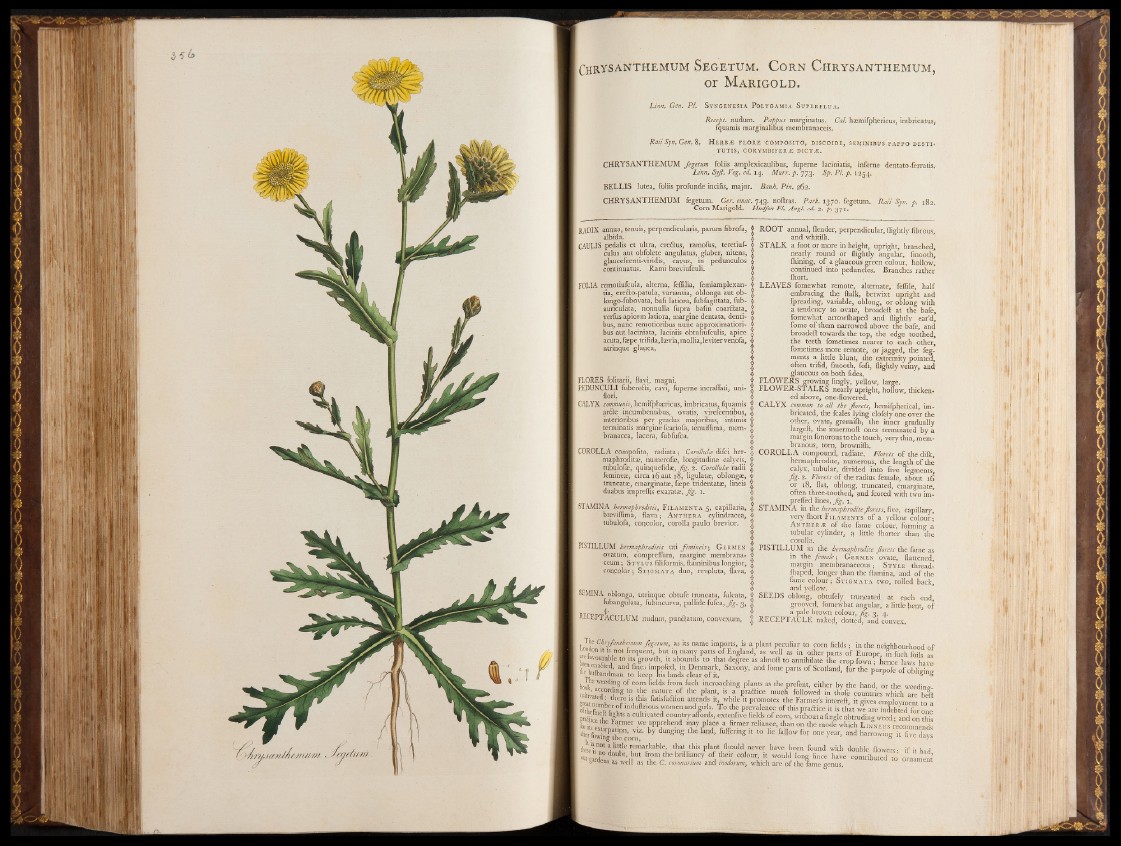
Linn. Gen, PI. Syngenesia Polygamia Superflua,
Recept, nudum. Pappus marginatus. Cal. hcemifphericus, imbricatus,
fquamis marginalibus membranaceis.
Raii Syn, Gen, 8. H erbie f lo r e c om po s ito , d iscoid e , semimibus.pa p po d e s t i -
T U T I § , CORYMBIFE-RAS DICTjE.
CHRYSANTHEMUM fegetum foliis amplexieaiïlibus, fuperne laciniatis, inferne dentato-ferratis^
Linn. Syft. Veg, ed. 14. Murr. p. 773. $p. PI, p. 1254,
BELLIS lutea, fpliis profupde incifis, major. Bauh, Pin. 262,
CHRYSANTHEMUM fegetum. Ger. emac. 743. noftras. Park. 1370. fegetum, Raii Syn. p. 182.
Corn Marigold. Hudfon Fl. Angl. ed, 2, p. 371.
I jiADIX annua, tenuis, perpendicularis, parum fibrofa, 6
albida. |
I CAULIS pedalis et ultra, erefilus, ramofus, teretiuf-
cuius aut obfolete angulatus, glaber, nitens, £
glaucefeentirviridis, cavus, in pedunculos $
continuatus.. Rami breviufculi. . f
fO^IA remotiufcula, alterna, feflilia, femiamplexan- y
tia, ereflo-patula, variantia, oblonga aut pb- 4:’
longo-fubovata, bafi latiora, fubfagittata, fub-
aunculata, nonnulla fupra bafin coarftata, |
verfus apicern latiora, margine dentata, denti- $
bus, nunc remotioribus nunc approximation- $
bus aut laciniata, laciniis obtuliufculis, apice i,
acuta, fæpe trifida, lævia, mollia, levjter venofà, h
utrinque glauca, ?
! FLORES folitarii, flavi, magni, $
I PEDUNCULI fubere&i, cavi, fuperne incraflati, uni- %
flori.
I ÇALYX communis, hemifphæricus, imbricatus, fquamis f
^r£le incnmbentibus, ovatis,. virefcentibus, À
intérioribus per gradus majoribus, intimis $
terminatis margine fcajiofa, tenuiflima, mem- f
branaçea, lacera, fubfufca.
I COROLLA compofita, radiata ; Corollulce difci her-? $
maphroaitæ, numerofæ, longitudine calycis, ^
tnbuîofæ, quinquefidæ, ßg. 2. Corollulee radii *
femineæ, circa 16 aut 18, ligulatæ, oblongæ, 0
tmncatæ, emarginatæ, fæpe tridentatæ, lineis
duabus irnprefljs exajratæ, fig. k.
6TAMINA hermaphroditism Filament a 5, capillaria,
breviflima, flava; A nther a cylindracea, h
tubujofa, concolor, corolla paulo brevior. X
f PISTILLUM bermapbroditis uti fiemineis; Germ en f
ovatum, comprefliim, margine membrana- $
ceum; Stylus filiformis, ftàminibus longior, 1
conçplqr ; S t ig m a t a duo, revpluta, flava. $
j SEMINA oblonga, utrinque obtufe truncata, fulcata, $
fubangulata, fubiqcurva, pallide fufca, fig. 3, 1 I 4. I
I HECEPTAÇULUM nudpm, punflatum, convexum, Î
ROOT annual, (lender, perpendicular, (lightly fibrous,
and whitifh.
STAUR a foot or more in height, upright, branched,
nearly round or (lightly angular, fmooth,
(hining, of a glaucous green colour, hollow,
continued into peduncles. Branches rather
fhort.
LEAVES fomewhat remote, alternate, feflile, half
embracing the (talk, betwixt upright and
fpreading, variable, oblong, or oblong with
a tendency to ovate, broadeft at the bafe,
fomewhat arrowlhaped and (lightly ear’d,
fome of them narrowed above the ba(e, and
broadeft towards the top, the edge toothed,
the teeth fometimes nearer to each other,
fometimes more remote, pr jagged, the feg-
ments a little blunt, the extremity pointed,
often trifid, fmooth, foft, (lightly vemy, and
glaucous on both (ides,
FLOWERS growing fingly, yellow, large.
FLOWER-STALKS nearly upright, hollow, thickened
above, one-flowered.
CALYX common to all the florets, hemifpherical, imbricated,
the fcales lying clofely one over the
other, ovate, greenifti, the inner gradually
largeft, the innermoft opes terminated by a
margin fonorous to the touch, very thin, membranous,
tom, brownifti,
COROLLA compound, radiate, Florets of the di(k,
hermaphrodite, numerous, the length of the
calyx, tubular, divided into five fegments,
fig. 2. Florets of the radius female, about 16
or 18, flat, oblong, truncated, emarginate,
often three-toothed, and fcored with two im-
prefled lines, fig, 1,
STAMINA in the hermaphrodite florets, five, capillary,
very (hort F i l a m e n t s .' of a yellow colour;
A nther as o f the fame colour, forming a
tubular cylinder, a little (horter than the
corolla.
PISTILLUM in the hermaphrodite florets the fame as.-
in the female; G er men ovate, flattened,
margin membranaceous; Style thread-
fhaped, longer than the (lamina, and of the
fame colour; Stigmata two, rolled back,
and yellow.
SEEDS oblong, obtufely truncated at each end,
grooved, fomewhat angular, a little bent, of
a pale brown colour, fiv. q 4.
RECEPTACLE naked, dotted, and convex.
I 1 i l r f a “ “ ’«, .as Its name imports, is a plant peculiar to corn fields; in the neighbourhood of
I a” 11 u,n0t firGtluent- bu5 "1 mai’ )' Pa® of England, as well as in other parts of Europe, m filch foik as
I tin t o growth, It abounds to that degree as almoft to annihilate the crop Town; hence laws have
I Qf H i fiel<js fromr r“ ch incroachmg plants as the prefent, either by the hand, or the weedinsr-
11® “ v e r a.tU/ a - ° f ‘ he Pi “ tj P f e Praftlce much fohowed in thofe countries which are be!l
I na mSi, f e V hr!S- fatmfaffton attends it, while it promotes the Farmer’s intereft, it gives employment to a
I “f th e S u I mdu?” °US J 0” “ “ V f ' T ° Pr™ ' encG ° f P la ic e it is that we are indebted for one
I PiaSice a C“ ItlVated extenfive fields of corn, without a Angle obtruding weed; and on this
I may place a firmer reliance than on the mode which L inneus recommends
I after C i g p'om ^ d Pg S h la!,d’ fu£rennS 11 to lle fa!!°w <°r one year, and harrowing it five days
l i l sI’a o J litLl e l ema?kablei. tJ,aL this plant Ihould never have been found with double flowers- if it had
0»t?arden«d«Ub ’ l^Ut brllIl“ cf ° P * 7 “ lour it would long fince have contributed to ornament’
I • S raens 4s well the C, coronanum and inodorum, which are o f the lame genus.